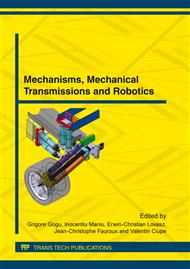p.204
p.214
p.224
p.234
p.242
p.252
p.258
p.266
p.276
Evaluation of Spring Implementation to Reduce the Required Motor Energy in a Walking Assist Exoskeleton with Linear Actuation (Walking Assist Machine Using Crutches)
Abstract:
Powered robotic exoskeletons used to assist in human locomotion require a lot of energy. The Walking Assist Machine using Crutches (WAMC) is such an exoskeleton used to assist paraplegic people in walking. It uses telescopic links actuated by DC motors and people wearing the device move crutches themselves. An simulation of the WAMC was done to see if the implementation of springs could lead to a reduction in required motor energy. The simulation showed that a configuration with springs reduces the required motor energy and increases the walking speed compared to the original configuration without springs. In the simulation the user had to spend more effort to swing the crutches forward, if the springs were implemented in the system.
Info:
Periodical:
Pages:
242-251
Citation:
Online since:
March 2012
Authors:
Keywords:
Price:
Сopyright:
© 2012 Trans Tech Publications Ltd. All Rights Reserved
Share:
Citation:


